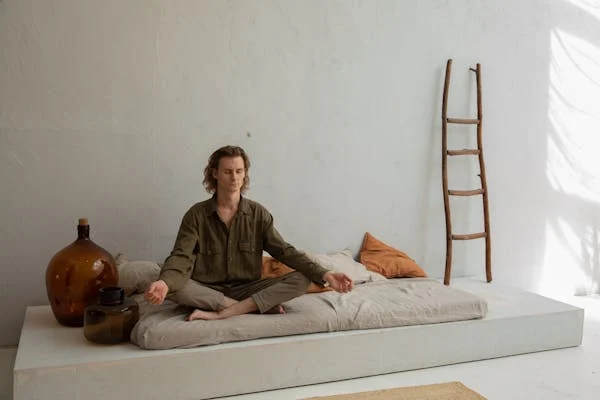Table of Contents
Introduction
The Lotus Pose, also known as Padmasana, is one of the most respected and iconic seated postures of yoga. Traditionally, this pose is usually used during meditation for its effects in enhancing mental clarity, focus, and spiritual growth.
Although its roots are deeply rooted in Eastern philosophy and spiritual practices, the physical and mental benefits of Padmasana can be experienced by anyone, regardless of age or skill level.
This blog will explore the many benefits of Lotus Pose, explaining how it can enhance flexibility, promote inner peace, and support a balanced mind-body connection.
Physical Flexibility Benefits
Padmasana requires specific flexibility, especially in the hips, knees, and ankles. In most people, these areas tend to be stiff, especially among those who sit for long periods or lead a sedentary lifestyle. Here’s how the Lotus Pose improves flexibility:
Improved Hip Flexibility: In the Lotus Pose, the legs are crossed in a peculiar way, with each foot resting on the opposite thigh. It gently opens the hips, thereby improving their flexibility. For tight hip patients, this flexibility improves significantly with time due to reduced tension.
Padmasana also provides a great flexure to the ankles and knees by being placed in the crossed-legged position, so they begin to become supple and will rarely get stiff when the body has adjusted to that posture.
The posture of sitting with the spine well aligned: When sitting in Padmasana, you are urged to sit straight up with an erect spine. This natural position of the back muscles strengthens it and helps eliminate the pain and discomfort caused by slouching or poor sitting habits.
Stretching the Groin: The external rotation of the thighs for Lotus Pose opens up this very tight area in many people; the groin can become a tight, limited place. This helps improve flexibility in the lower body by stretching out this part of the body.
The other end is Lower Body Strength. Of course, Lotuses mainly enhance flexibility but definitely engage and improve the strength surrounding the hips and knees as well as ankles through time.
Ultimately, stability also improves, as it would create an easy ride for one performing other exercises based on lower strength.

Psychological Benefits, Mental Clarity
While the physical benefits of Padmasana are known, the psychological benefits it offers are no less important. This pose is a powerful tool for calming the mind and improving emotional health:
Reduces Stress and Anxiety: The stillness of the Lotus Pose, combined with deep breathing, activates the parasympathetic nervous system—the part of the nervous system responsible for relaxation.
As a result, regular practice of Padmasana helps lower levels of cortisol (the stress hormone) and promotes feelings of calm.
Promotes Mindfulness: Lotus Pose is often used as a foundational pose for meditation. Sitting in this position naturally draws your attention inward, fostering mindfulness.
It becomes easier to let go of distracting thoughts and focus on the present moment, which is key to developing a meditative state.
Mental Clarity: The positioning of the body in Padmasana and focusing on the breath tend to clear up mental fog, thus providing a mental clarity. Many report feeling clearer and able to make better decisions when doing this pose; they face life’s challenges calmly and with centered minds.
Increased Concentration: The discipline required to maintain Padmasana enhances concentration. It helps the mind stay focused for extended periods, making it ideal for practitioners who engage in deep meditation, study, or other activities that require sustained attention.


Spiritual and Energetic Benefits
Mind-body connection is developed not only on the aspects of the physical and mental but also relates to the aspect of spirituality in yoga. The lotus pose is considered a cornerstone of spiritual practices, especially in developing oneself with the inner self as well as the universe:
Balancing Chakras: The most important use of Lotus Pose is thought to be in balancing the body’s energy centers or chakras.
In fact, Padmasana is particularly useful in activating the root chakra (Muladhara) through grounding of the body and stability, in addition to stimulating the crown chakra (Sahasrara) at the topmost end of the head. This balance offers a sign of contact with both earth and higher consciousness.
It grounds and connects: Padmasana provides a sense of grounding and connection to the earth. People, sitting upright with a straight spine and focused intention, often experience a deeper sense of stability and grounding, which helps them feel more centered and connected to their surroundings.
Symbolism of Spiritual Growth: The lotus flower from which the pose is derived is a symbol for spiritual awakening and the blooming of inner wisdom.
The lotus flower, in a metaphorical sense, rises from mud to bloom pure, so it is a symbol for spiritual growth, personal transformation, and unfolding of higher consciousness in the case of Lotus Pose.
Circulation and Blood Flow Enhancement
The physical alignment and posture of the Lotus Pose stimulate circulation throughout the body with its many benefits, including the following:
Improving Blood Flow to the Pelvic Region: In crossing the legs and sitting erect, blood flows toward the pelvic region. This tends to make the lower extremities healthy and improves all round circulation.
Boosts Venous Return: The legs in Padmasana position support venous return, the process by which blood returns to the heart from the extremities. This may help reduce swelling in the legs and feet, especially for those who spend a lot of time standing or sitting.
Reduces Swelling and Discomfort: Lotus Pose helps alleviate swelling and discomfort in legs with enhanced blood circulation and reduced pressure on veins. This can help reduce the likelihood of developing conditions such as varicose veins.


Digestive Health
The configuration of your body in the Lotus Pose may even positively impact your digestive system in the following ways:
Stimulates the Digestive Organs: The cross-legged position applied creates a subtle compression in the abdominal region to stimulate the functioning of the organs of digestion.
This action assists in the movements of food being passed through the digestive tract to facilitate the healthy functioning of stomach and intestines.
Relieves Constipation: As the abdominal area is gently compressed, the flow of digestion is enhanced, relieving constipation and encouraging regular bowel movements. The pose also reduces bloating and improves overall digestive efficiency.
Promotes Detoxification: The improved circulation and stimulation of the digestive organs support the body’s natural detoxification processes, helping to eliminate waste and toxins more effectively.
Improves Breathing and Respiratory Health
Breath control, or pranayama, is an integral part of yoga, and Padmasana supports effective breathing practices. Here’s how it enhances respiratory health:
Encourages Deep Breathing: The upright position of the Lotus Pose naturally encourages deep, diaphragmatic breathing. This type of breathing helps fill the lungs with air, increasing oxygen intake and promoting relaxation.
Increases Lung Capacity: With continued practice, padmasana has the effect of expanding the lung and increasing its capacity.
People practicing deep breaths while in the pose boost their ability to take in deeper breaths with more air-which is precisely what those searching for ways of improving their endurance and respiratory muscles need.
Promotes Relaxation: Deep, conscious breathing in the Lotus Pose helps activate the parasympathetic nervous system that causes the relaxation response of the body. Tension is relieved, the nervous system is soothed, and heart rate decreases.
Improves Mental Discipline and Emotional Balance
It takes much patience, concentration, and self-control to be able to reach the full Lotus Pose. The benefits of emotional and psychological attributes include:
It helps in Enhancing Emotional Stability: Regular practice of Padmasana helps a person build mental discipline, which in turn builds emotional stability. The calm and focused state it fosters makes you handle stress and emotional challenges better.
Helps Build Patience and Perseverance: Reaching the full expression of Lotus Pose takes time and practice. The process teaches patience and perseverance qualities that can be applied to any area of life.
Promotes Self-Awareness: Padmasana encourages a deep connection with your body and breath, leading to increased self-awareness.
This mindfulness practice can help you better understand your emotional and mental patterns, leading to greater emotional intelligence.


Benefits for Practitioners of Yoga and Meditation
For those who already practice yoga or meditation, the Lotus Pose offers specific benefits:
Best for Meditation: Lotus Pose is usually known as the traditional pose for meditation because it can maintain all types of physical stabilities that create a mental clarity state. Practitioners are allowed to sit in stillness for long periods without discomfort, thus enabling deep and focused meditation.
This asana is also beneficial for the practitioners of yoga since it enhances flexibility and concentration. The mental clarity and the benefits of physical structure gained through the Lotus Pose allow for better connectivity and concentration while performing other practices of yoga.
It helps in the alignment of Padmasana so that you can have a stable base for practicing pranayama. The alignment of your body enables better flow of air so that breath control exercises, which improve energy levels and focus, can be performed effectively.
Steps to Master the Complete Lotus Pose
Mastering the full Lotus Pose takes time and practice if you are new to it. Here’s a step-by-step guide:
Start with Hip-Opening Exercises: Before attempting Padmasana, practice hip-opening poses like pigeon pose, butterfly pose, or lizard pose to prepare your body. These poses help increase flexibility in the hips and groin area.
Ease Into the Pose Gradually: Don’t rush into the full Lotus Pose. Start by sitting in a cross-legged position and gradually bring your feet higher onto your thighs as your flexibility improves.
Use Props for Support: If sitting upright is very challenging, a cushion or a yoga block should be placed beneath your sit bones. This tends to tilt your pelvis forward, and makes it easier to sit up well.
Focus on Alignment: Ensure your spine is straight, shoulders are relaxed, and your head is aligned with your spine. Gaze forward and breathe deeply in the pose to stay present and focused.
Conclusion
The Lotus Pose, or Padmasana, offers a myriad of physical, mental, and spiritual benefits. From enhancing flexibility and circulation to promoting mental clarity and emotional balance, this powerful yoga posture connects the body and mind in profound ways.
Whether you’re looking to deepen your meditation practice, improve your flexibility, or find inner peace, incorporating Lotus Pose into your routine can be a transformative experience.
Lotus Pose offers the best chance for you to achieve higher levels of wellness, self-understanding, and spiritual development, so long as you embrace the practice with patience and mindfulness.
